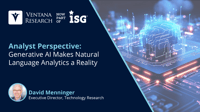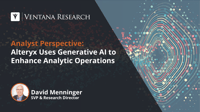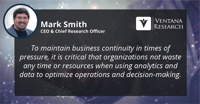We’ve been saying for years that natural language processing (NLP) and natural language analytics would greatly expand access to analytics. However, prior to the explosion of generative AI (GenAI), software providers had struggled to bring robust natural language capabilities to market. It required considerable manual effort. Many analytics providers had introduced natural language capabilities, but they didn’t really resonate with enterprise requirements. They required significant effort to...
Read More
Topics:
business intelligence,
Artificial intelligence,
natural language processing,
Analytics & Data,
AI and Machine Learning,
GenAI
Alteryx was founded in 1997 and initially focused on analyzing demographic and geographically organized data. In 2006, the company released its eponymous product that established its direction for what the product is today. In 2017, it went public in an IPO on the NYSE. At the time of the IPO, Alteryx was focusing much of its marketing efforts on the data preparation market, particularly to support Tableau. Throughout this time though, Alteryx offered much more than data preparation. As a...
Read More
Topics:
business intelligence,
Analytics,
data operations,
Analytics & Data,
AI and Machine Learning,
Analytic Operations
In my perspective on decision intelligence, I lamented the fact that business intelligence technologies have left the rest of the exercise to the reader for too long. Making a decision is a process that involves many steps and many people. Decision-making is so complicated and divorced from day-to-day business processes that organizations have had to create entirely separate teams to focus on the analytics and data to support it. One aspect of the decision-making process that can be enhanced by...
Read More
Topics:
business intelligence,
Analytics,
Digital Technology,
Analytics & Data,
Collaborative & Conversational Computing
Organizations are becoming increasingly aware of the potential value that can be gained by processing big data. As data sources grow, it becomes important to have tools and methods to effectively process, analyze and visualize this information from disparate systems and warehouses.
Read More
Topics:
business intelligence,
embedded analytics,
Analytics,
Streaming Analytics
I have written before about the continued use of specialist operational and analytic data platforms. Most database products can be used for operational or analytic workloads, and the number of use cases for hybrid data processing is growing. However, a general-purpose database is unlikely to meet the most demanding operational or analytic data platform requirements. Factors including performance, reliability, security and scalability necessitate the use of specialist data platforms. I assert...
Read More
Topics:
business intelligence,
Cloud Computing,
Data Management,
Data,
Analytics & Data,
Analytic Data Platforms
Organizations are continuously increasing the use of analytics and business intelligence to turn data into meaningful and actionable insights. Our Analytics and Data Benchmark Research shows some of the benefits of using analytics: Improved efficiency in business processes, improved communication and gaining a competitive edge in the market top the list. With a unified BI system, organizations can have a comprehensive view of all organizational data to better manage processes and identify...
Read More
Topics:
business intelligence,
embedded analytics,
Data Governance,
Data Management,
natural language processing,
data operations,
Streaming Analytics,
AI & Machine Learning,
operational data platforms
I have written previously that the world of data and analytics will become more and more centered around real-time, streaming data. Data is created constantly and increasingly is being collected simultaneously. Technology advances now enable organizations to process and analyze information as it is being collected to respond in real time to opportunities and threats. Not all use cases require real-time analysis and response, but many do, including multiple use cases that can improve customer...
Read More
Topics:
business intelligence,
Analytics,
Internet of Things,
Data,
Digital Technology,
Streaming Analytics,
AI & Machine Learning,
Analytics & Data,
Streaming Data & Events
Teradata introduced some enhancements to its Vantage platform last year in which they expanded its analytics functions and language support, and strengthened tools to improve collaboration between data scientists, business analysts, data engineers and business personnel. Some of the key enhancements included expanding the native support for R and Python, extending the ability to execute a wide range of open-source analytics algorithms, and automatic generation of SQL from R and Python code....
Read More
Topics:
business intelligence,
embedded analytics,
Analytics,
Collaboration,
Data Preparation,
Information Management,
Data,
AI & Machine Learning
The amount of data flowing into organizations is growing exponentially, creating a need to process more data more quickly than ever before. Our Data Preparation Benchmark Research shows that accessing and preparing data continues to be the most time-consuming part of making data available for analysis. This can potentially slow down the organizational functions which depend on the analysis results. Trying to get ahead of the backlog with incremental improvements to existing approaches and...
Read More
Topics:
business intelligence,
embedded analytics,
Analytics,
Collaboration,
Data Governance,
Data Preparation,
Data,
Information Management (IM),
data lakes
Analytics and data provide visibility into an organization’s past, present and potential performance. However, not all organizations are using analytics that provide timely insights — insights that not just reflect what happen but direct a successful course for the future. Demand for personalized and relevant insight only intensifies in a black-swan event. To maintain business continuity in times of pressure, it is critical that organizations not waste any time or resources when using analytics...
Read More
Topics:
business intelligence,
embedded analytics,
Analytics,
Business Intelligence,
Collaboration,
Internet of Things,
Data,
Digital Technology,
natural language processing,
Conversational Computing,
AI & Machine Learning



















